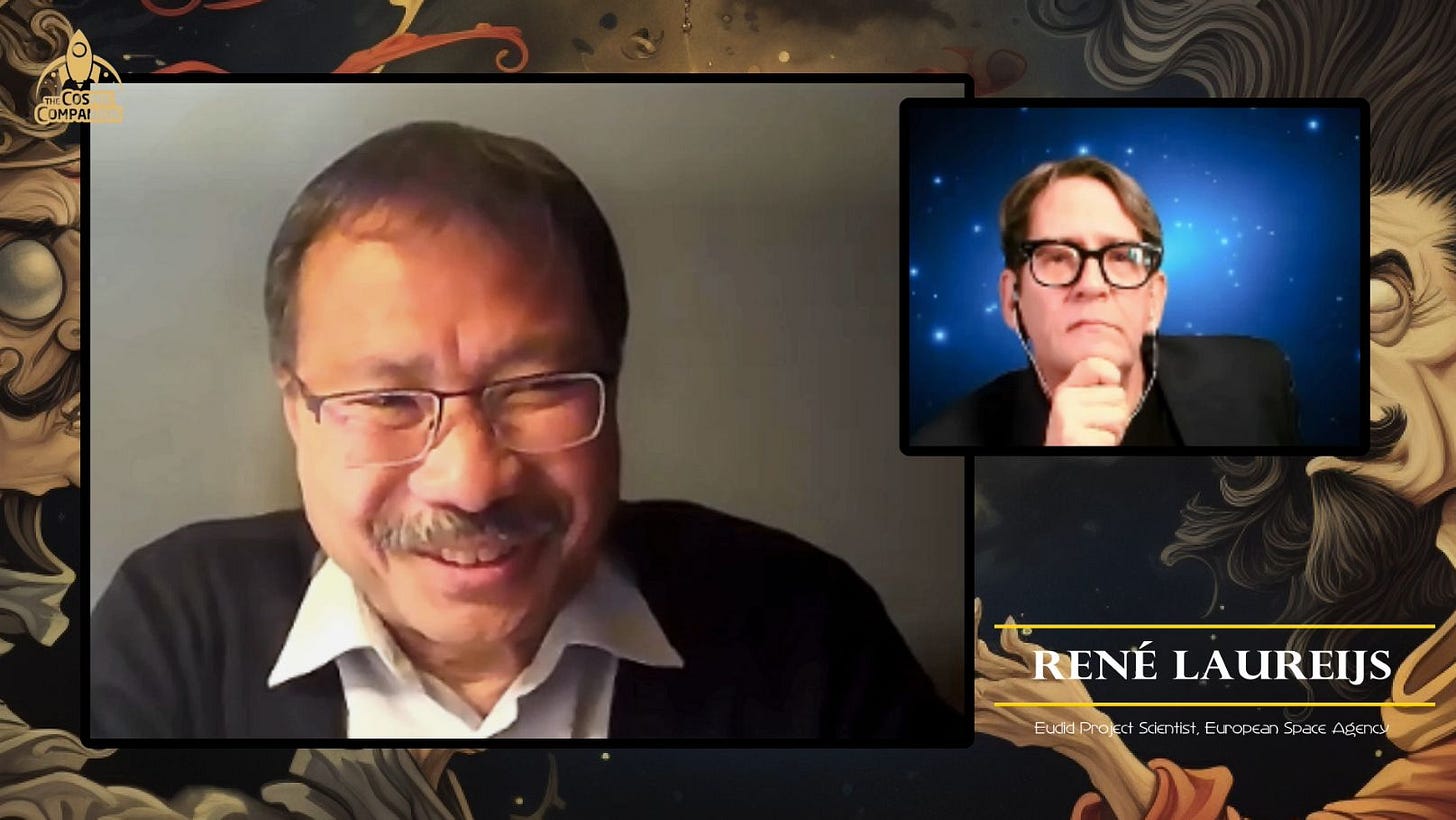This week on The Cosmic Companion, we talk about the mysteries of Dark Matter and Dark Energy. Later in the show, we will be joined by René Laureijs, Euclid Project Scientist, from The European Space Agency.
If one were to look at all the matter and energy in the Universe, about 68% is dark energy, 27% is dark matter, and just five percent is everything we see around us. 95% of everything out there — is totally unknown.
[That’s chicken feed. What IS most of the Universe?] Good question!
René Laureijs appears on The Cosmic Companion 12 August 2023. Creative Commons 4.0 Attribution 2023 The Cosmic Companion.
Dark matter, in short, are regions of gravity, moving stars and galaxies around with — apparently — nothing there to cause it. It’s a bit like an unseen poltergeist, pushing things around, leaving us scratching our heads, wondering what just caused the lamp to fly across the room. [<<<]
The tale of dark matter begins 90 years ago, in 1933. This was the year when Albert Einstein emigrated to The United States, work began on San Francisco’s Golden Gate Bridge, and prohibition was repealed. Meanwhile, astronomer Fritz Zwicky was studying the great Coma cluster of galaxies, finding their movements suggested this galactic group had 10 times as much total mass as everything which could be seen in the region.
Astronomers called this mysterious, unseen “stuff” dark matter. Because this invisible something acts like matter, except... it’s dark.
In the 1970’s, astronomers Vera Rubin and Kent Ford were studying the rotational rates of spiral galaxies, expecting stars to move more slowly at their rims than near their centers. Instead, stars near the outer rims of galaxies were spinning faster than expected, seemingly defying the laws of gravitation.
Rubin and Ford suggested this unseen… dark… matter… might be Zwicky’s… dark matter.
Now, let’s unveil the prime suspects for what dark matter might be. One theory suggests it’s made up of WIMPs (Weakly Interacting Massive Particles), which interact with regular matter through gravity but are otherwise the universe’s best hide-and-seek champions. Another candidate is axions, hypothetical ultra-lightweight particles that could fill the universe like a cosmic fog. Or, dark matter may be MACHO’s — small objects giving off too little light to be seen by astronomers. Or maybe our ideas of gravity are wrong.
Today, researchers are in a galactic scavenger hunt to uncover more about dark matter.
On 1 July, the Euclid mission launched to space, on a quest to uncover the mysteries of dark matter and its cosmological antagonist dark energy. Next up, we talk with René Laureijs, project scientist on this remarkable mission.
Dark energy’s effects are like the cosmic equivalent of a gentle nudge, pushing galaxies apart like an invisible chaperone at a cosmic teenage dance party. Observations show that for the last several billion years, at least, galaxies have been racing apart from each other at an increasing rate.
Imagine being on a roller coaster. After coming down the first big hill, your cart will be at its maximum speed (That’s The Big Bang). If your cart then heads slightly uphill, you might (rightly) expect the cart to slow down. But, suppose it started speeding up instead? That would require the application of energy.
The energy to drive the increasingly-quick expansion of the Universe is the result of… Well, no one really knows yet. Hence, Dark energy.
In the late 1990s, two independent teams of astronomers were studying the expansion of the Universe using observations of distant supernovae (exploding stars).
Their observations indicated that something was counteracting gravity’s influence, causing galaxies to move away from each other at a continually increasing pace.
But what could dark energy be? The theories are as diverse as the flavors at an intergalactic ice cream parlor. Some think it’s a property of space itself, akin to an anti-gravitational stretchiness that makes the universe expand faster. Others suggest it might be linked to a new type of particle, sneaking around undetected like a cosmic ninja.
As we venture deeper into this cosmic ballet, one thing’s certain: the universe has more surprises in store, and dark matter and dark energy are the backstage maestros orchestrating it all.
Next week on The Cosmic Companion, we will take on a weighty subject — Gravity! What is it? How does it work? And why does it keep getting you down? We welcome Joe Swiggum from the NanoGrav collaboration to the show, talking about the weakest — yet most familiar — force in the Universe. Make sure to join us, starting on 19 August!
If you enjoyed this episode of The Cosmic Companion, please subscribe, share, and follow our show on whichever format you are using right now. I’m pretty sure we’re on there!
Clear skies!
James













Share this post